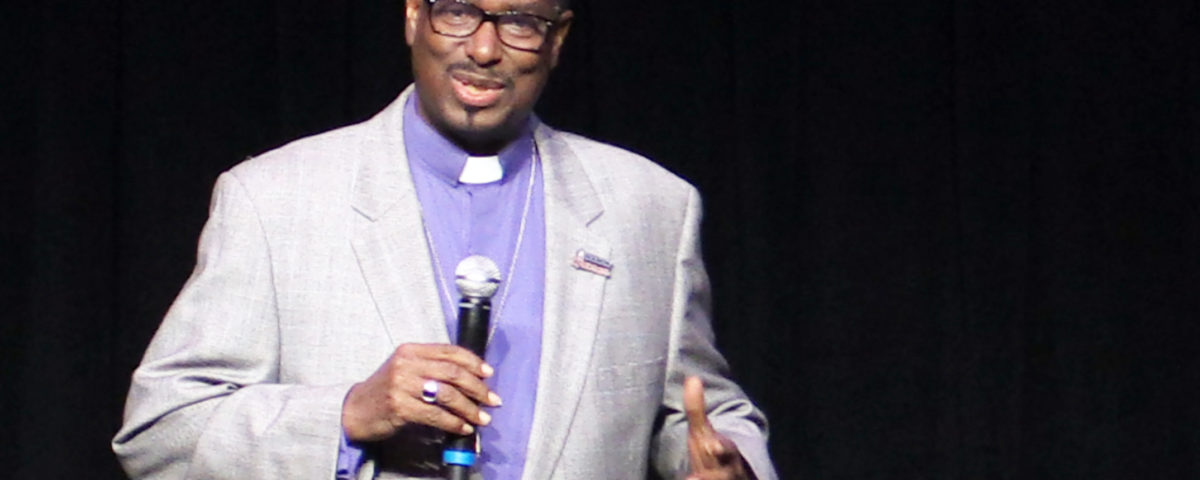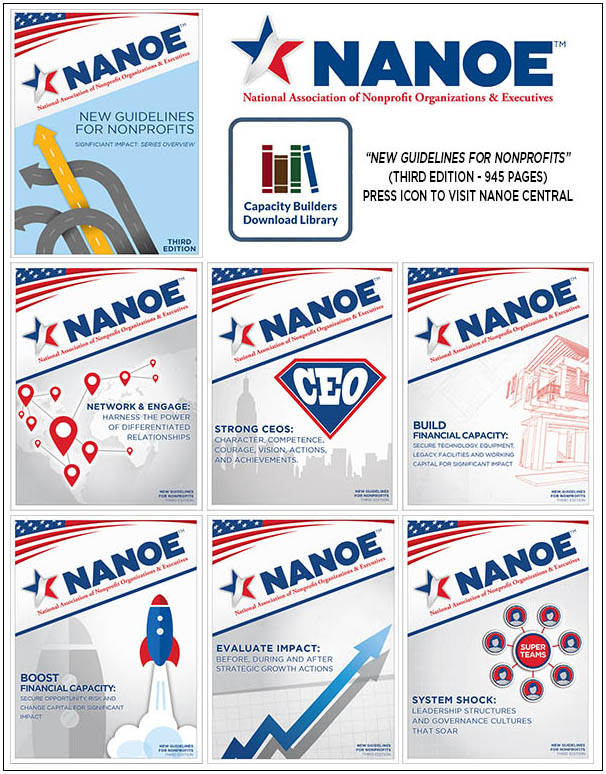How to Start Your Own Nonprofit Sponsorship Program
January 11, 2019[PODCAST] What’s Next? with Amy Eisenstein
January 14, 2019Is NANOE Legitimate? Nonprofits Have Answered

Is NANOE Legitimate? Despite universal praise from donors, foundations, executives, volunteers and board members celebrating NANOE’s alternative to nonprofit dysfunction, the question – Is NANOE Legitimate – continues to be raised by National Networks, State Associations, For-Profit Consultancies and Industry Media Outlets.
Why? The answer is simple – NANOE’s founders are messing with everybody’s money.
According to Holly Hall of Inside Philanthropy, “Critics seems to fear the competition the National Association of Nonprofit Organizations & Executives (NANOE) poses to their own financial interests. Indeed, with the number of associations serving nonprofits rising over the years, along with other trends such as online materials that make conferences less necessary, some associations like the Council on Foundations and the Association of Fundraising Professionals have struggled.”
After watching the short video above I think you’ll see why the establishment keeps asking the self-serving question – Is NANOE Legitimate.
Allow me to share my first-person-witness to NANOE’s origins. It’s a story about two leaders named Jimmy LaRose and Kathleen Robinson who had the courage to ask the question, “why doesn’t charity work?” They did more than just answer the question. They did years of study and field-testing to offer charities an alternative – an alternative that ensures Nonprofit CEOs succeed.
LaRose & Robinson Enter The Same Sphere – White House Office of Faith-Based and Community Initiatives (WHFBCI) is established in 2001
In 2001, President George W. Bush’s sought to strengthen faith-based and community organizations and expand their capacity to provide federally funded social services, positing that these groups were well-situated to meet the needs of local individuals. President Bush appoints Don Willett as White House deputy to head up this initiative. Jimmy LaRose meets with Willet privately in the White House’s OEOB contributing to the formation of this office and would eventually be appointed by the U.S. State Department as a specialist visiting emerging democracies around the world to foster cultures of Corporate Social Responsibility. On a completely unrelated matter, Clemson University’s Institute for Families and Neighborhood Life was selected by the White House to distribute WHFBCI federal funds for the State of South Carolina. These financial distributions were overseen by the Institute’s Director, Kathleen Robinson who served in this position from 1998-2009.
Neither Jimmy or Kathleen would meet until 2006.
LaRose & Robinson read Paul Light’s “Sustaining Nonprofit Performance: The Case for Capacity Building and the Evidence to Support It” – 2004
Both Jimmy & Kathleen, (still not having met) read Paul Light’s “Sustaining Nonprofit Performance: The Case for Capacity Building and the Evidence to Support It.” Paul Light’s work was based on an anecdotal study (not an empirical one) that significantly influences the White House Office of Faith-Based & Community Initiatives, state & local governments, foundations and donors challenging them to invest in capacity-building (as opposed to their service programs.) His premise, “The nonprofit sector survives because it has a self-exploiting work force: wind it up and it will do more with less until it just runs out. But at some point, the spring must break.” Both LaRose & Robinson shared these same beliefs for decades and continued to affect the nonprofits within their spheres of influence.
LaRose & Robinson Meet – 2004
Kathleen attends an awareness event for a social impact charity hosted by Jimmy LaRose’s National Development Institute and experiences the value of LaRose’s capacity-building model. As part of her responsibility to distribute federal funds Kathleen underwrites the costs for grant recipients to receive capacity-building technical support provided by LaRose for the next three years.
LaRose & Robinson Oversee National Development Institute & Clemson University Study – 2010
After nearly a decade of overseeing grant distribution Robinson observed (anecdotally) that the nonprofits receiving these funds were not developing into sustainable organizations. In other words Paul Light’s directives where not working. In December 2010 she determined to perform a statistical survey of nonprofits to determine why an influx of monies into a nonprofit failed to result in significant impact. She approached LaRose knowing that he had developed the largest database of nonprofit executives in the world. They invited 52,300 nonprofits leaders from across the United States to participate. Four hundred seventy nonprofit leaders responded reaching a clinical sample. The purpose of the study was to examine leaders’ motivations for building organizational capacity, the organizational dynamics present, and the effects of these two things on nonprofit performance and productivity. The survey included many of the questions that Paul Light (2004) originally asked to determine the factors that marked high performing nonprofits. They were asked to indicate what capacity building efforts they had done in the past five years, and to select one past and one future capacity building effort to evaluate in depth. The study revealed that 85% of charities built no additional capacity but more importantly 15% succeeded in expanding their revenues. In that, a clinical sample of 470 participants was reached the research group was able to study the success factors unique to the 15% of charities that reached and exceeded their goals. Here a just a few of the characteristics of the 15%:
1. They had at least one C-Suite Level Executive (CEO, CFO, COO, CDO etc.) with a business background based in free-market enterprise principles.
2. They built more capacity over a five year period than those nonprofits who indicated they stagnated or declined during the same time period.
3. They grew budget, programs & donors, despite the recession.
4. They grew their nonprofits regardless of the size/involvement of their board.
5. They externalized their mission for the purpose of revenue generation (versus program expansion)
6. They developed board members who evaluated the chief executive and promoted the goals and values of the CEO.
They also determined that 85% of nonprofits were so poorly structured that no amount money would improve their ability to achieve impact.
Factors Explaining a Nonprofit Executives Intention to Build Capacity – Dr. Kimberly Brown – 2011
Based on the NDI/CLEMSON study Dr. Kimberly Brown wrote a 400 page doctoral thesis (overseen by Dr. Robinson) based on the NDI’s & Clemson research named Factors Explaining a Nonprofit Executives Intention to Build Capacity. Brown’s thesis becomes the empirical cornerstone upon which LaRose & Robinson launch a movement to transform the charitable sector.
RE-IMAGINING PHILANTHROPY – Jimmy LaRose -2014
In order to make the statistical study and doctoral thesis accessible to the general public Jimmy LaRose writes RE-IMAGINING PHILANTHROPY based on the research group’s findings. Jimmy takes donors, volunteers and board members on a wild ride into the upside down world of nonprofit management using an “emperor has no clothes” approach to confront the “crazy-making” that’s paralyzed the charitable sector for the decades. His book receives critical praise and sells over 15,000 copies.
NEW GUIDELINES FOR NONPROFITS – Kathleen Robinson – 2015
Dr. Robinson spends a three years working with the original study data and Brown’s doctoral thesis and writes the 945 page reference manual named New Guidelines for Nonprofits. Robinson makes six major recommendations to develop a nonprofit in a manner that achieves significant impact. To put it another way, New Guidelines for Nonprofits identifies the factors that ensure nonprofits go to scale.
LaRose & Robinson respond to vitriolic response from industry establishment by forming NANOE – 2016
Jimmy & Kathleen with great excitement and naivete distribute New Guidelines for Nonprofits to industry media outlets, national nonprofit associations and state nonprofit networks. Though their work is universally celebrated by nonprofit executives they are castigated by the intermediaries and media outlets. Why? Because their findings undermine the products, services and training sold by state and national nonprofit networks and For-Profit Companies who advertise in industry media. As shared earlier, Jimmy & Kathleen were messing with everybody’s money. In response, LaRose & Robinson form a new organization to disseminate their findings sector-wide. Hence, National Association of Nonprofit Organizations & Executives (NANOE) was born. They structured NANOE by closely following the principles they learned during their research. Within only 24 months NANOE becomes the fastest growing nonprofit network member organization in the United States with 1,135 members experiencing and become credentialed in New Guidelines for Nonprofits. Industry intermediaries and media outlets become further enraged including United Way Worldwide, Association of Fundraising Professionals, Certified Fund Raising Executive and a plethora of State Nonprofit Network Associations. Furthermore, Nonprofit Quarterly, Chronicle of Philanthropy and Industry Bloggers write a series of articles disparaging the creation of NANOE. In response, NANOE’s newly formed board of directors create their own media outlets named https://InsideCharity.org & https://501c3.Buzz to gain control of the national narrative.
Broken For Good: The Way Charity Works in The United States of America – Honnie Korngold
CineVantage’s documentary film maker, Honnie Korngold answers the question – Is NANOE Legitimate – by observing the tumult within the sector and was inspired to produce a full length documentary film. Broken for Good: The Way Charity Works In The United States of America slated for a much earlier release but had to be extended because of the myriad of revelations the film’s script writers uncovered during their investigation of nonprofit management. What was once a 2 year film shoot has turned into a 5 year passion project, in part, because of the vitriolic response the charitable sector has had to the original study, Brown’s dissertation, RE-IMAGINING PHILANTHROPY and New Guidelines for Nonprofits.
For more insight read Louis Fawcett’s (NANOE’s President) NANOE Declaration to answer the question – Is NANOE Legitimate.
Simply put, the answer to the question – Is NANOE Legitimate – IS A RESOUNDING YES!
Is NANOE Legitimate – Nonprofit Have Answered was written by Bishop Redfern II: Bishop Redfern II, presiding Bishop of the Ecumenical Church of Christ, is the founding Board Chair of the National Association of Nonprofit Organizations & Executives. He has been named by the Association of Fundraising Professionals as its Volunteer Fundraiser of the Year and United Way’s Alyce Kemp-Dewitt Award Winner. Redfern, has served as the Chief Executive Officer in a diverse array of companies worldwide. He is known for his innovative leadership and management skills and a track record of providing companies with the leadership, organizational and operational tools they require for sustained profitable growth.
Is NANOE Legitimate – Nonprofits Have Answered was first posted at https://InsideCharity.org


1 Comment
[…] and then a precipitous drop to only 8% for operational and office staff. In the Nonprofit sector, 70% of those organizations have no Strategic or Adaptability Plan at all in place, much less a Succession […]